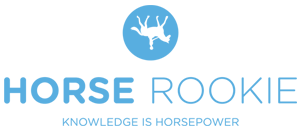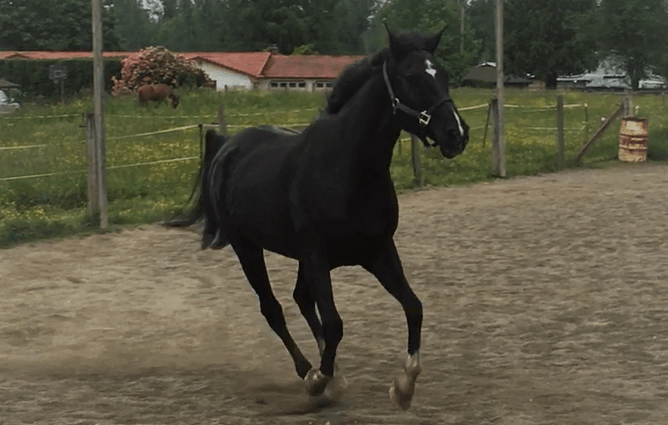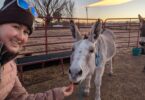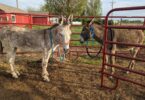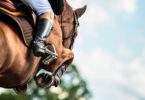Chip Learns a Bit More
In a different post, I introduced Rose to you, a spirited and affectionate Arabian-Saddlebred mare. In this post I introduce a second horse, Chip. The idea is to have you join me as we track the progress—including the ups and downs of Chip. The journey we take with our horses is where we learn the most, so I invite you into mine.
Meet Chip, fifteen-year-old Thoroughbred-Welsh Cob gelding. Boasting a stunning black coat, three white socks and a beautiful star on his face, he has always reminded me of Black Beauty. His legs and shoulders are skinny and tall like a Thoroughbred’s, but his barrel, rump and neck are all stocky like a Welsh Horse. His tail flips up like an Arab’s when he gets to racing around the turnout arena. Chip is a trail horse at heart. Born in Oregon, raised in Idaho, and now residing in Washington, he is a Pacific North West Pony through and through, with hundreds of trail miles under his belt (and, I reckon, plenty of granola and Stumptown coffee).
His first trainer used him as a parade pony, so he does well with people and cars. He loves attention, lives for cookies, and expresses his affection through hard work and pleasing his rider.
The Focus
Chip knows the basics of arena work, moving off the leg, and collection. Being predominantly a trail horse, he does not spook easily. With that in mind, I would like to polish his collection, build up the muscle tone in his legs, shoulder, neck and back, and teach him to carry a rider well at the canter.
Chip is the type of horse who tries to figure out his rider’s next move, so I would also like to develop an attitude of listening over anticipating.
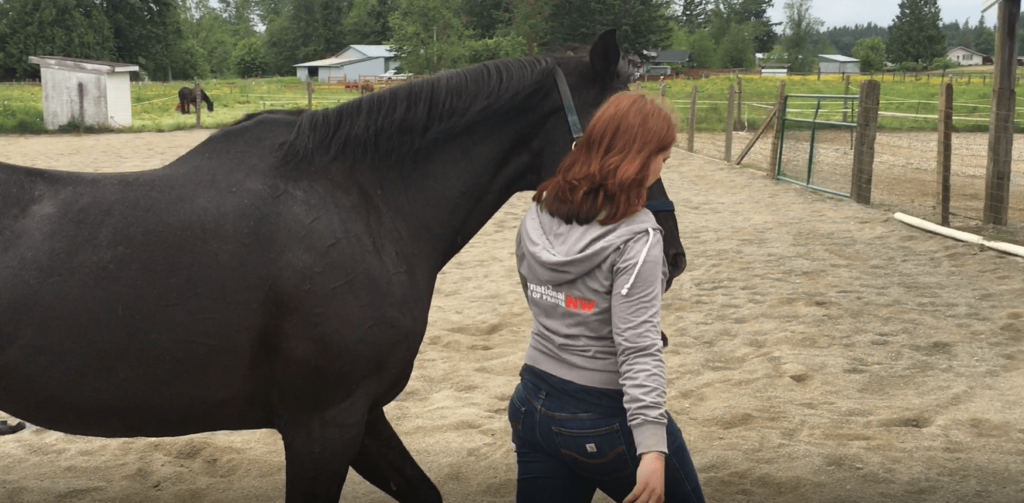
Photo Credit: Lindsey Rains
The Prep
This session started with a quick brushing and tack-up. We are dealing with some major shedding right now in Western Washington, so by the time I finished brushing him, I looked like I had a second sweater on. I brought out his English saddle, which is still new to him. My steady fellow still looks at it sideways, but accepts it nonetheless. I almost ditched it entirely because of how uncomfortable he was the first few times with it.
Before selling the saddle, I asked for a second opinion from a barn friend about the fit. She said it should fit him fine, just to check for sweat marks after each session. Perplexed because of his squeamish behavior under the English saddle, I wondered if he was reacting to the amount of contact from the legs that he didn’t experience with a Western saddle. The last time I rode him, I kept my legs off him best I could, and he went from nervous to settled within a minute.
Lunge-Line
After tacking up, I lunged him under saddle and he had a lot of energy. I asked him to canter with my voice and he stepped into it right away. After about ten laps, he settled back down into a trot. The other direction lunging also went great: he listened to every command to go from trot to canter, back down to trot, up to canter again, then back down to a nice, forward trot again.
Chip is very attuned on the lunge line. I suspect someone did join-up with him at the beginning of his training, because his inclination is to walk to the center to meet me whenever his work is done, and then follow me even if he’s not on the line.
I would like to develop a solid “hoa” on the lunge line, however, and possibly spend more time each session lunging to help develop his lateral muscle strength.
Under Saddle
Chip started out with a big spring in his step, but I didn’t let him step into a trot until we had good couple laps walking. We worked on pace at first, which is something that took a good year to get down pat. He was a bracing bundle of nerves in the arena when I first started riding him. So in this session, I made sure we could get a slow, thoughtful trot around the arena.
I had to correct my riding posture because his nose was bent outwards towards the rail. Counter-clockwise is his bad direction already, but my seat wasn’t helping. After some fidgeting, I succeeded by sinking much deeper into my left heel. This seemed to correct my posture to the point that he bent back slightly to the inside of the arena.
I have noticed in previous sessions that if I get distracted while trotting him, he loses his cool and falls into a very forward, disorganized trot that clearly reflects both of our nerves. I should mention that Chip also has a real struggle with cantering in the arena.
Out on the trail, Chip will open up into a canter or gallop no matter the terrain or surroundings.
In the arena where bending and collection is involved, cantering is often a mess. His solution is to rush through it, lower his head and kick out his back legs if I ask for a canter longer than he anticipates. If any given session includes cantering, he will be nervous in the next session until the cantering part is over.

Photo Credit: Lindsey Rains
Chip tries to be a mind-reader. If he anticipates that I will ask him something that he’s uncomfortable with, he’ll try to get it over with and will be a ball of anxiety until the dreaded THING is over. For a few months, my solution was to just avoid cantering completely. A relaxed horse yields more productive riding sessions all around.
Chief Rookie Aside: Wearing helmets is super important. Get one and wear it always!
But today I was taking advantage of the fact that he was already happy to see me (I’d been gone for a month and he was desperate for attention).
After some trotting circles and full, relaxed laps at a jog around the arena, I bent him into a half-arena circle going clockwise. Coming around the open (mid-arena) bend of the circle, I slid my inside (right) leg forward and my outside leg back a little, looked straight ahead across the arena, sank deep into my heels, took a deep breath, kissed at him and gave him a gentle squeeze.
And a perfect transition into the canter? NOT.
Like I said, his experience with arena cantering is a nervous, agitated mess. But this time, he offered me something new. I was doing my best to communicate exactly what I wanted him to do, and he tried his best to come through. What he ended up doing was a super sped-up trot/hop ensemble, but his shape was on-point.
So, I settled him back to a walk, gave him some pets and praises, and confirmed with a witness that he was, indeed, trying to pick up the canter. Then I moved him into a relaxed jog again. After a couple of laps, I asked him for a more forward trot.
He was listening, waiting. When we got to the same open bend in my half-arena circle, I made the same shape with my seat, took a deep breath, and squeezed again. Chip took two heavy trot steps, then rounded his back into a confident canter stride. It clearly took a lot of effort on his part to hold this gait in this shape. His lateral muscles are not developed, and he was outside his comfort zone. After a few canter strides, I settled him back to a walk, and gave him praises and pets again, of course.
This victory was so sweet, because he pushed past his fear and irritation with arena cantering, and offered all his effort to accomplish it.
I went through the same motion again, and he picked it up in two strides instead of three. I relaxed him back into a jog then walk within a lap of our circle, and gave him all the pets and praises. He did wonderfully, and I wanted to end with him “winning.” We walked back to the mounting block and I dismounted. We ended our session with him grazing in the back pasture.
Roadblocks and Issues Review
Chip is still squirrelly in the English saddle. He is used to a big western saddle with wide stirrup flaps that hold the rider’s toes parallel to the horse’s side. The flaps also provide a buffer between his belly and his rider’s leg. When riding in the English saddle with a minimal stirrup leather, all he feels is my leg. And of course, as a practiced English rider, all I wanted was to hug him with my toes pointed slightly outward, resting my calf completely on his belly.
Horses are extremely sensitive (they can feel a fly on their belly even through their thick skin), so he could surely tell the difference between his old saddle and this new one. Since that revelation, I’ve been making a conscious effort to slowly adjust him to more leg contact. I had to focus on keeping my toes forward, my calf parallel to his belly and not wrapped around it. He told me when my leg was getting too snuggled up to him. His head shot up and his gait became nervous and choppy.
In our practice circles, I reinforced leg aids with closer contact, which he seemed to understand. This came in handy when picking up the canter, our second roadblock, because I used closer contact with my legs to hold him in a nice bend. The canter is still awkward and an obviously big effort for him, which I attribute to his simple lack of experience and lateral muscle tone. Following the canter breakthrough we had, however, I was very encouraged.
Victories from This Session
The best victory from this session was Chip’s great effort to pick up the canter. I have seen him put this much focus into other exercises, but never with the canter. It has been far outside of his comfort zone as long as I’ve ridden him. Furthermore, he did not give his classic signal of frustration: crow-hops (small bucks with his back legs).
He took well to engaging the closer contact from my legs under the English saddle. This is something I’d like to accustom him to over the next few months.
Going Forward
I ended this session with a plan for the next session. Through the following goals, I hope to see development in Chip’s training over the next few months.
- “Hoa” on the Lunge Line. Chip is responsive overall on the lunge line, but he will not do a dead stop on the line. Instead, he will slow to a walk, turn and walk towards me. While this practice doesn’t bother me at the end of the lunging time, I’d rather associate this behavior with a unique command, and to teach him that “hoa” is universal for “stop in your tracks and stay that way until further instruction.”
- Lateral Strength. While Chip understands the shape of collection, it is often rigid and slow. His bending often involves some tilting, even without a rider. I would like to build up his ability to carry himself and bend well without it being rigid (i.e., uncomfortable for him). This will also help him build his back muscles (which is good for longevity) and keep him lighter in the bit. I will take two approaches: 1) more time on the lunge line, and 2) a practice of tight and loose circles in each session.
- Leg Aids in the English Saddle. At the moment, Chip is uncomfortable with the degree of leg contact from the English Saddle. I want to reinforce the purpose of close contact by getting him familiar with the cues that come from the legs.
- Trot to Canter Transition. In the coming months, I will help him become more comfortable with picking up the canter. I expect to see this improve with both practice and an increase in strength.
Chip is a thoughtful horse, in the sense that he tries to anticipate his rider’s next move. The most productive moment in each session with him is when he transitions from trying to figure out my next move to listening for my next cue. This is the point where he begins to relax and truly focus.
Consistency is key with Chip. He is one hundred times more settled if he knows that he is doing what his rider asks of him. He does get bored easily, so in future sessions, I will work on the same exercises but in varying orders.
He loves the challenge, though, and a job well done.
P.S. Enjoy this article? Trot on over to:
- Can horses sense fear and anxiety?
- 33 Things you can do today to calm your riding nerves forever
- How do you overcome fear after falling off a horse?
- How can I calm my nerves before horse riding?
- 3 Fear-Free Secrets to Gain Your Horse’s Trust & Respect
